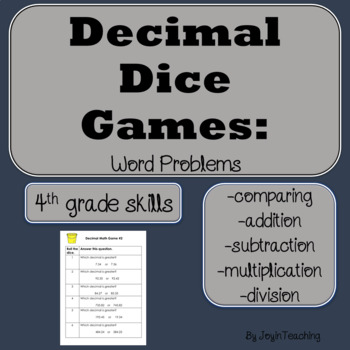4th grade Decimal Word Problems - comparing, place value, addition, subtraction
- PDF
Description
Use these 4th grade dice games as a fun way to practice decimal word problems. Students will compare decimals, identify place value and practice addition and subtraction with decimals. These no-prep math activities engage students in their learning.
You could use decimal dice games as a center or in a small group or for partner work or independent work. They could even be used as fun homework assignment to practice word problems with decimals.
Students will roll the dice and then answer the word problem next to that number.
If you use these as a center, you may want to copy the answers onto the back of the dice games. Then they would be self-checking. If they are a center, you may want to pair up higher readers with lower readers.
Print out copies of the recording sheet for each student. They will need one copy for each game they play. If this is at a center, you could laminate the recording sheets or put them in a sleeve.
These games are 4th grade level.
Games 1-2- Which decimal is greater?
Game 3-4 - Which decimal is less?
Game 5- Put decimals in order from least to greatest.
Game 6- Put decimals in order from greatest to least.
Game 7- Put decimals in order from greatest to least (or least to greatest).
Game 8- Word Problems: Addition
Game 9-Word Problems: Subtraction
Game 10-Word Problems: Addition/Subtraction
Game 11- Word Problems: Multiplication
Game 12-Word Problems: Division
Game 13- Word Problems: Multiplication/Division
Game 14- Word Problems: Comparing Decimals
Check out these other math products from my store.
4th 5th grade Decimals Place Value Dice Games - standard, word, expanded form
https://www.teacherspayteachers.com/Product/4th5th-grade-DecimalsPlace-Value-Dice-Games-place-value-and-expanded-form-1211720
3rd/ 4th grade: Place Value Dice Games: id place value/ round numbers
https://www.teacherspayteachers.com/Product/3rd-4th-grade-Place-Value-Dice-Games-id-place-value-round-numbers-1165289
4th grade: Winter Sports Dice Games: Multiplication Division Word Problems
https://www.teacherspayteachers.com/Product/4th-grade-Winter-Sports-Dice-Games-Multiplication-Division-Word-Problems-1044467\
Free Product
https://www.teacherspayteachers.com/Product/3rd-grade-Winter-Sports-Dice-Games-Multiplication-Division-Word-Problems-1044460





